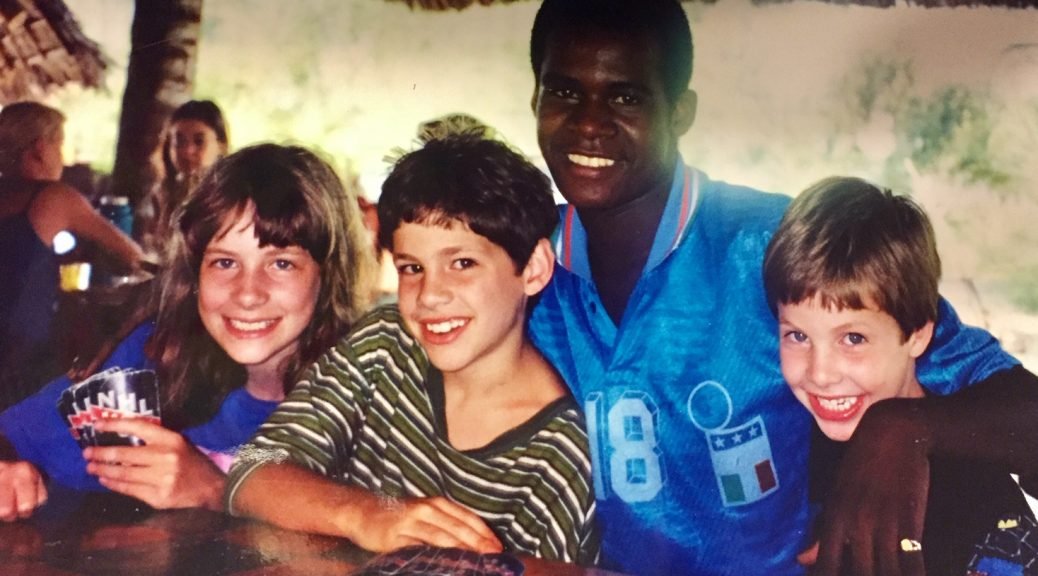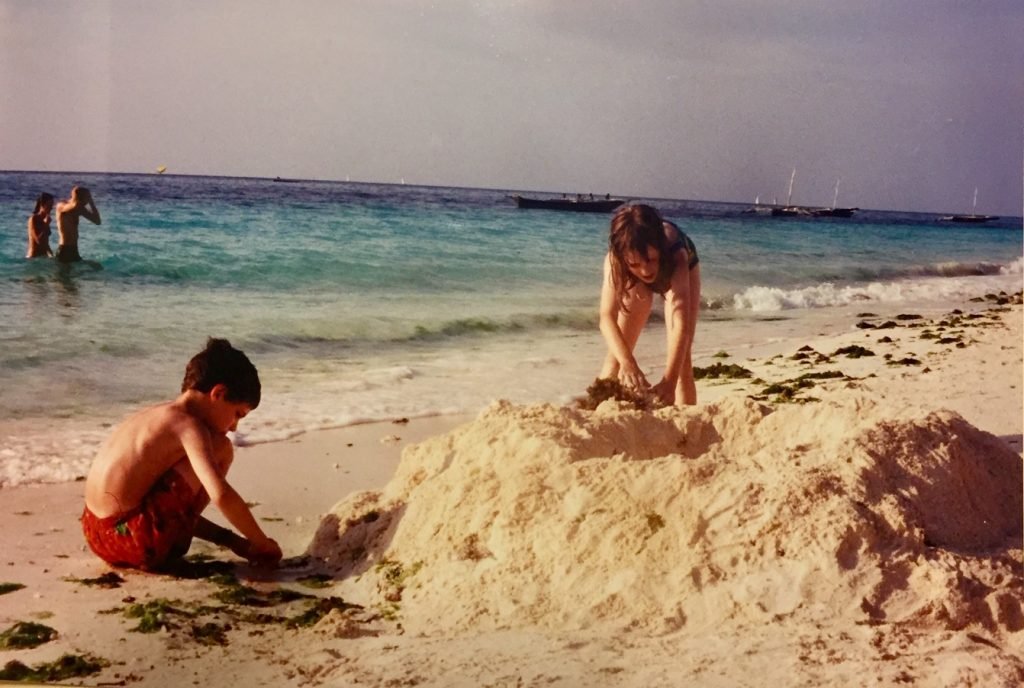
The Road to Zanzibar
Sometimes on a very long, very challenging trip, it is a
good idea to take a holiday within your holiday. Our family had been travelling
rough for nearly five weeks through Africa in 1998 and were fresh off an
exhilarating six-day camping safari in four of Tanzania’s most famous national
parks. Rachel 10, Danny, 8, and Sam, 6, absolutely loved seeing Africa’s wild
animals in their natural habitat, but it was time for something different.
Something mellow. From the beginning I wanted us to include the island of
Zanzibar in our trip plans and my wife Philippa agreed.
I had spent a wonderful week there in 1982 at the end of a three-month journey
utilizing virtually every form of land and river transportation from the
Central African Republic to Tanzania, and I found Zanzibar to be a fascinating
and exotic place to soothingly chill out. It was also great for the kids with
its gorgeous beaches, delicious food and friendly people. We spent 17
unforgettable days there, but even in quiet Zanzibar we had some unexpected
adventures.
We took a two-hour ferry ride on February 7 from the then capital of Tanzania, Dar es Salaam, to the island and settled into the Old Stone Town section of Zanzibar city, a World Heritage site that we immediately fell in love with. After a little searching and shopping we found the perfect hotel, the Old Stone Inn, with big comfortable beds, a powerful ceiling fan that actually worked and mosquito nets without holes. It was hot, averaging 32C (90F), so the fan was badly needed. This was our biggest splurge in our 12-week African backpack, but it was worth every penny.
We never tired of walking the narrow, winding streets of the Old Stone Town, a maze of very narrow alleys lined with houses, shops, bazaars and mosques like an historic relic from the days when the Sultan of Oman ruled the island. It was built for people on foot, long before the invention of the automobile. It seemed like there was a surprise around every corner, including a man on a bicycle almost running us over. Even with a map we were constantly lost and couldn’t care less. We did not want to be rescued.
There was always another fascinating shop, an overhanging balcony, an elegantly carved Arab or Indian door or a gaggle of school children chanting the Koran inside a school building. There were Arabic coffee houses, shops with colourful fabrics, and many old structures made of coral stone giving the buildings a warm, reddish hue like the Palace Museum, formerly the home of Zanzibar’s sultans. Toss in the lovely, near deserted beaches, the spice tours, boat rides to charming nearby islands and it’s not surprising that no one, including us, wanted to leave when the time came.
The relentless heat drove us to one decadent act in Zanzibar. We hailed a cab to the International Supermarket, relatively equivalent to an Edmonton corner grocery store, scooped up two litres of ice cream, cabbed it back to our hotel, and sat with the fan going full blast, stuffing down the ice cream. It was frozen solid but we couldn’t wait. We just muscled it out with a big spoon and gobbled it down like starving refugees.
For dinner nothing compared to the freshly cooked food on the sea front in Zanzibar. Each night as darkness settled, the food stalls opened and hundreds of people gathered around the charcoal fires. There were crafts to buy, and tangy king prawns, luscious kebabs and a host of vegetarian delights to sample. The mingled smells of the food and the sea, the sounds of chattering people and the friendly atmosphere kept us coming back night after night.
Renting a vehicle in Africa is an expensive option that didn’t work to well the one time we tried it. We spent a crazy day driving around the island in a dilapidated wreck we had to push to get started. Tip – if the car you have just rented has to be pushed out of the lot to get it going, stop right there and demand your money back. Some of the roads were so wretched people were actually passing us on foot!
Later the van started making terrible grinding noises and breaking down repeatedly. The children loved push-starting it, but we were afraid the owner would try to charge us for the damage this must be doing to the van. Finally, the police stopped us on the highway to ask what was causing the racket. They said they were afraid that we would cause an accident. Incredibly, the owner wasn’t upset. In fact, he apologized for the problems and offered us a new car to rent the next day. No thanks.

The kids spent part of nearly every day splashing about in the Indian Ocean with us. They loved building sand castles in between short trips back into the water. On our third day in Zanzibar we rode a small boat to nearby Prison Island (aka Chawguu Island), which was once the place where slaves were incarcerated until they were sold. It is estimated that 3.3 million of these East African slaves were auctioned off.
The kids enjoyed the water and built sand castles but especially loved the giant tortoises that were protected animals on the island. Danny and Rachel were allowed to climb on one of the tortoises, which made their day. The only day the kids didn’t get to the beach was the day we went on a spice tour, taking a taxi to a plantation where a guide walked us through fields of lemongrass and other spices. There were cloves, nutmeg, cinnamon, black pepper and much more. A delightful experience.

Philippa and I decided that we should go to the northern tip of the island and spend a week at the fishing village of Nungwi, which had great beaches and some bungalows. We got up early to take a minibus taxi there over some really rough roads. The kids adored the beach, but we didn’t have a fan the first night and it was so hot only Sam was able to sleep. We moved bungalows, but found the fans in the new place didn’t work either. Nevertheless we loved Nungwi.

I remember lying on the prefect beach there one evening as Arab dhows and small fishing boats sailed past, watching the local village women wading into the water at sunset, laughing and gossiping and wearing metal pots on their head. The women split into two groups. Half of them held out a huge fishing net, while the rest pounded the water with their pots and shouted, driving many fish into the net. Afterwards, they headed back to their village in the fading light, carrying their bounty and chattering happily. This simple but delightful ritual was repeated every evening, but very few travellers paid much attention. I watched it every night as I felt I was looking at a fascinating traditional practice.
Sadly, we had one ugly experience in Nungwi. One night each of the kids bought inexpensive necklaces for themselves and put them on. We went for a walk on the beach but couldn’t see well because there was a power outage. Suddenly Sam said that he had lost his necklace and we began searching for it. A local man suddenly appeared and asked what we were looking for. He said if he found the necklace we should give him one thousand Tanzanian shillings. We ignored him but he suddenly announced he’d found it. I asked him to give it back, but he wouldn’t. I called him a thief just as we walked into the village where many locals were standing around. One told him to give the kid his necklace back but the thief ignored him. I wanted to get the necklace but was not prepared to start a fist fight with a local man in his village. Just then two muscular Australians and a woman walked up and asked what was going on. Philippa told them about the necklace. “Beat the shit out of him,” the Australian woman said. One of the men then put the thief in an arm lock and I pushed him up against a wall and said “Hand it over.” The second Australian then put his hand around the man’s neck and squeezed hard until he returned the necklace. I’m glad we got Sam’s necklace back but the entire experience left a bad taste in my mouth and was the absolute low point of our time in Zanzibar.
As the trip went by the kids learned a lot about Africa’s geography and even learned to speak some basic Swahili, including the names of the most famous wild animals and counting up to ten. Sometimes our narrow knowledge of East Africa’s primary language came up a little short however. One day in Nungwi we found ourselves surrounded by curious women and children. The women, wearing colourful wraparound skirts and clutching babies in their arms, were jabbering excitedly and pointing at our kids. In our best Swahili we listed their names and ages, but there was something else the women wanted to know, something about Rachel that we simply couldn’t fathom. Suddenly the boldest of them stepped forward, brushed back Rachel’s hair, inspected her ears, and then grabbed her crotch. Rachel jumped back in astonishment, but they got their answer. Yes, she is a girl. I guess they don’t see too many local girls wearing shorts and a t-shirt.
At the end of our 12-week journey, Philippa asked all of us to give our picks on 19 different categories about the trip. One category was named “Favourite Place” and all five of us picked Zanzibar. There is something magical about that wonderful island.
Read the previous posts about our family trip to Africa:
3 thoughts on “The Road to Zanzibar”
Another wonderful chapter to what must surely be a book Tommy…well done. jc
Thanks JC. Zanzibar is a wonderful place. As or a book, I am certainly considering it.
Wonderful post,, Those are beautiful pictures of your trip.. seems like it’s a great place to come and visit and have a wonderful trip story like you did..
btw.. thank you for sharing,